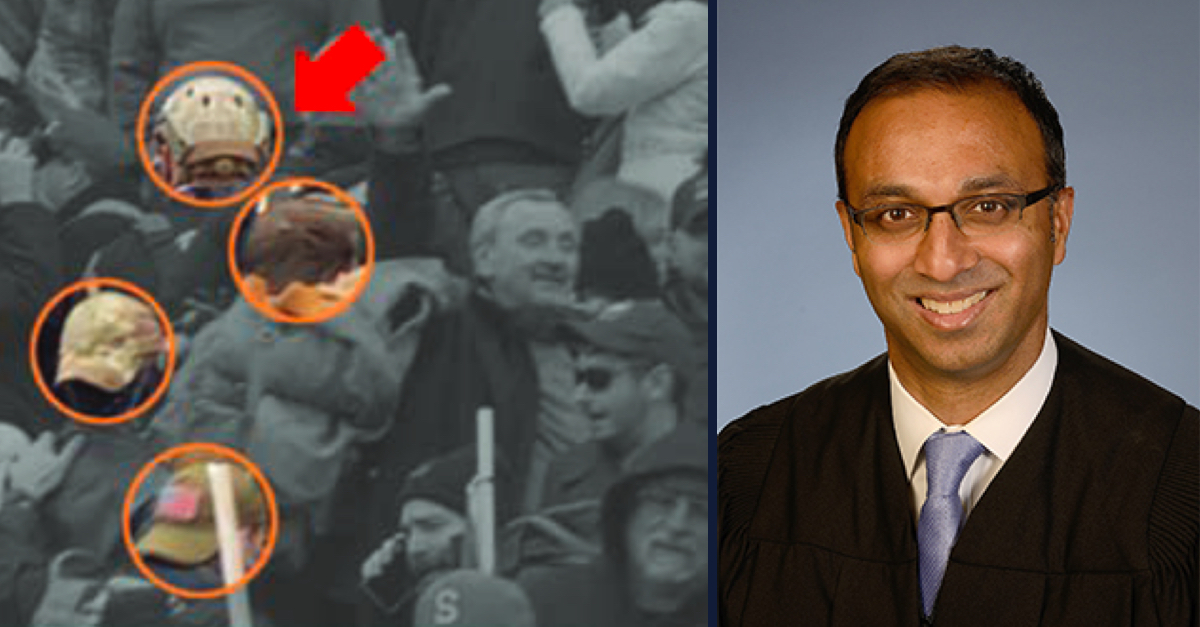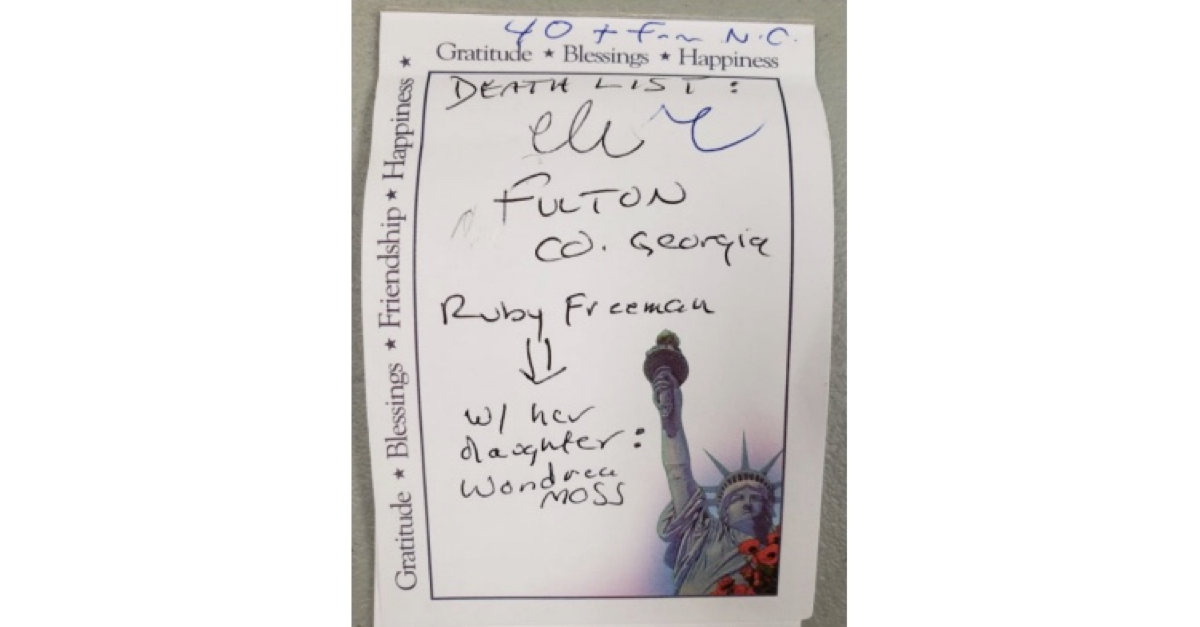
Members of the Oath Keepers allegedly approach the Capitol in a “stack” formation on Jan. 6, with the red arrow indicating Kelly Meggs (via FBI court filing); U.S. District Judge Amit Mehta (via U.S. District Court for the District of Columbia).
A federal judge played the role of law professor on Monday in a series of sharp exchanges with lawyers for members of a right-wing extremist group charged with seditious conspiracy in the Jan. 6 attack at the U.S. Capitol.
U.S. District Judge Amit Mehta, in an hours-long hearing Monday, was ruling on several motions ahead of an anticipated Sept. 27 trial date. One of those motions was a request from the government for an order precluding the defendants from making certain defenses, including the so-called “public authority” defense and a defense of entrapment by estoppel.
The public authority defense can be asserted by someone with an “actual or believed exercise of public authority on behalf of a law enforcement agency or federal intelligence agency at the time of the alleged defense.” An entrapment-by-estoppel defense would allow a defendant to claim they were told by law enforcement that their actions were lawful when they were, in fact, not.
Juli Haller, a one-time “Kraken” lawyer who was part of the effort to overturn Joe Biden‘s victory over Donald Trump in the 2020 presidential election, told Mehta on Tuesday that she intends to assert an entrapment by estoppel defense on behalf of her client Kelly Meggs.
Haller had briefly mentioned that she believed that Trump’s Dec. 19 “will be wild” tweet, to which her client apparently responded on social media, “does implicate estoppel.”
“Ms. Haller, that’s sort of a drive-by,” Mehta said. “I don’t know what you mean.”
Haller elaborated by saying that she didn’t want to have a “blanket waiver” of the public authority defense.
“How is a tweet that says ‘Come to the Capitol on Jan. 6, it’s going to be wild,’ how does that provide the foundation of a public authority defense?” Mehta asked.
Haller said that the defense rests on an “equitable argument” that a person in a position of authority or law enforcement wrongfully “leads someone to do something ‘criminal,'” such as crossing a barrier.
“That’s not entrapment by estoppel, that’s lack of knowledge that you weren’t supposed to be there,” Mehta responded.
“That would be reliance on the lack of notice,” Haller replied.
“That’s not entrapment by estoppel,” Mehta reiterated, adding that an example of entrapment by estoppel would involve a police officer directing someone to go somewhere prohibited and then arresting them.
After some more elaboration from Haller, Mehta said that she was far from proving that she had a good foundation to assert the defense.
“The only thing you’ve told me so far is you’re going to rely on a tweet and Mr. Meggs’ response to that tweet, which comes nowhere close [to establishing the defense],” Mehta said. “Not under any conception of the law does it come close.”
Haller indicated that she had thought attorney Brad Geyer, who represents Kenneth Harrelson, would be the first to make the entrapment by estoppel argument, but Mehta pressed forward with Haller.
“Are you intending to advance an entrapment by estoppel defense, and if you are, what is your proffer?” the judge asked.
Haller said that the facts to support such a defense included that officers were told to open the doors to the Capitol, that surveillance footage shows officers didn’t stop protestors from opening the doors, and that there is evidence that Capitol police “were told to go home early on the day of the Capitol incident.”
She also said that there is evidence that people were “waved in” by police.
“Was Mr. Meggs waved in by anyone?” Mehta asked.
“There was nobody telling him not to go in,” Haller replied.
“That doesn’t mean you can go in,” Mehta responded, laughing in apparent disbelief. “Just because you’re not told you can’t go in, doesn’t mean you can go in.”
Moments later, attorney Geyer stepped in to offer his take on the availability of the defenses.
“Officers bellowed out to the crowd: ‘We understand that this is your house, we’re going to get with your leadership to get you up and on to the steps,'” Geyer said.
“Mr. Geyer, is Mr. Harrelson going to say he heard that officer?” Mehta asked.
“No,” Geyer replied. “Mr. Harrelson is going to say he was there for security detail.”
“If your theory is that he was entrapped by estoppel, doesn’t he have to have heard that he was invited on to those steps?” the judge asked.
Geyer hedged, saying that it “remains to be seen” whether Harrelson will testify.
Mehta was again unconvinced, but said he would revisit the issue if the lawyers could present stronger evidence.
“The bottom line is this: if you intend to assert either of these defenses, I’d like to see evidence,” the judge said. “What I’ve seen so far doesn’t even come close. Not even close. So you have got to give me a full-throated explanation of how you’re going to prove up an entrapment by estoppel.”
Mehta then turned to Geyer directly, whose recent court filings have signaled a developing theory that the Capitol riot was planned by agitators other than his client and co-defendants.
“Mr. Geyer, I’m going to tell you this right now: I don’t want to hear about suspicious actors and how there may have been a group of people who had conspired to make all this happen, alright?” Mehta said. “That’s not what an entrapment by estoppel [defense] is. It is a defense that is designed to be one that is based upon the conduct and statements of people who are officials. And the fact that there may have been some number of people in there who are suspicious actors trying to lure [people] into the Capitol building doesn’t give you an entrapment by estoppel defense.”
“So if either defendant wants to establish this defense or advance it, I’ll hear you out, but you’re not getting there right now,” Mehta added.
Defendant’s ‘Death List’ Is Too ‘Inflammatory’ For Jury to See: Judge
Mehta did grant some defense motions on Monday, including a request by defendant Thomas Caldwell to exclude evidence of a so-called “Death List” that Caldwell allegedly created that shows an apparent belief in conspiracy theories surrounding the presidential vote in Georgia.
The words “Death List,” followed by a colon, are at the top of what appears to be a page from a notepad. “Fulton Co. Georgia” are written below “Death List,” and then the names of two women: Ruby Freeman and Wandrea Moss, a mother and daughter who served as volunteer election workers.
The note ironically appeared on stationery bearing the preprinted words “gratitude,” “blessings,” “friendship,” and “happiness.”

Image via an FBI court filing.
Both were the targets of a conspiracy theory, amplified by Trump attorney Rudy Giuliani and others, implying that Moss had handed Freeman “USB drives” containing illicit votes. In memorable testimony before the House committee investigating the Jan. 6 Capitol attack, Moss said that she had actually handed her mother a ginger mint.
“This is not a doodle,” prosecutors said in the government’s opposition to Caldwell’s motion to exclude the list from evidence. “In its own words, it is a ‘Death List.’ One that Caldwell kept in his house during the charged conspiracy that names individuals involve din the 2020 Presidential Election and includes details about where they worked and how they were related to one another.”
Prosecutors argued that the list is relevant to showing Caldwell’s state of mind and intent to oppose the authority of the government by force, and that relevance outweighed the evidence’s prejudicial value.
David Fischer, Caldwell’s attorney, implied that the government was deliberately mischaracterizing the document.
“When it’s convenient to fit their narrative, they take things literally when they’re meant as jokes,” Fischer said.
“They’ve made several over the top claims based on their interpretation of evidence that turned out to be not accurate,” Fischer later added.
Mehta pushed back on that position somewhat.
“I wonder how many people go around writing the words ‘Death List’ and then put two peoples’ names underneath it,” the judge mused.
While Mehta indicated that he was troubled by the note, he nevertheless found that its “potential for inflaming the jury is quite high” and decided it was too prejudicial, given its relatively limited relevance to the actual charges at hand.
“It is a a fairly shocking thing to see, in my view, and really frankly hard to explain,” Mehta said. “That said, just because it’s shocking and hard to explain doesn’t mean it’s going to be probative as to his state of mind.”
“This is a highly prejudicial and highly inflammatory document, and I believe that the two people who are listed here may have also been . . . publicly identified,” Mehta continued. “So I think there’s a real danger here of this kind of document inflaming the jury.”
“It Could Be a Reaction Force, Just Not a Quick One.”
Mehta reached the same conclusion about the government’s intention to introduce evidence that defendant Jessica Watkins had bomb-making instructions inside her home. Prosecutors say they found these documents, believed to be derived from the website “The Anarchist’s Cookbook,” which itself was a book published in 1971 that provided step-by-step instructions for building certain explosives.
“The recipes found relate to ‘Making Plastic Explosives from Bleach’ and producing ‘Thermite,’ a known pyrotechnic,” prosecutors say in a motion in support of the evidence. “The government has not established when Watkins came into possession of these instructions.”
Prosecutors had argued that regardless of whether the government found any actual bombs or bomb-making ingredients inside Watkins’ residence, “the instructions alone are evidence of Watkins’s motive, opportunity, and knowledge under [evidence rules] to use that information to accomplish her criminal objective involving force against the government.”
Mehta disagreed and ordered the evidence to be excluded.
“I’m not going to allow those pages to be admitted,” he said. “I don’t think the government has made out the connection between those pages and the charged conspiracy. The government has not established, for example, when Ms. Watkins came into possession of those pages. There’s absolutely no evidence [linking Watkins’] reliance on those pages to the alleged conspiracy, or any discussions among any co-conspirators or un-indicted co-conspirators about bomb making being part of the alleged offense.”
It wasn’t all losses for the government on Monday, however. Mehta rejected a motion from defendants Thomas Caldwell, Meggs, and Watkins to exclude evidence of alleged co-conspirator Jeremy Brown’s transportation of explosives to the Washington area in an RV, finding that it was relevant to the conspiracy allegations.
Attorney Fischer had argued that the fact that the RV was located in College Park, Maryland, about a 30 minute drive from Comfort Inn in Virginia, undermined the prosecution’s theory that the RV was part of the alleged “Quick Reaction Force” the accused Oath Keepers had allegedly assembled.
“It could be a reaction force, just not a quick one,” Mehta cracked.
Ultimately, Mehta ruled that the evidence of the explosives in the RV could be admitted at trial. He acknowledged that the evidence was prejudicial, but not prejudicial enough to justify its exclusion.
“All evidence that the government wants to introduce is prejudicial, but the question is whether the probative value is outweighed by the prejudicial value,” Mehta said, outlining the calculation all judges must make when determining whether to allow evidence at trial. “I don’t think it meets the standard here. It doesn’t substantially outweigh it.”
The first Oath Keepers trial is set to start on Sept. 27.
[Image of Oath Keeper members on Jan. 6 via court filing; image of Judge Mehta via U.S. District Courts.]
Have a tip we should know? [email protected]